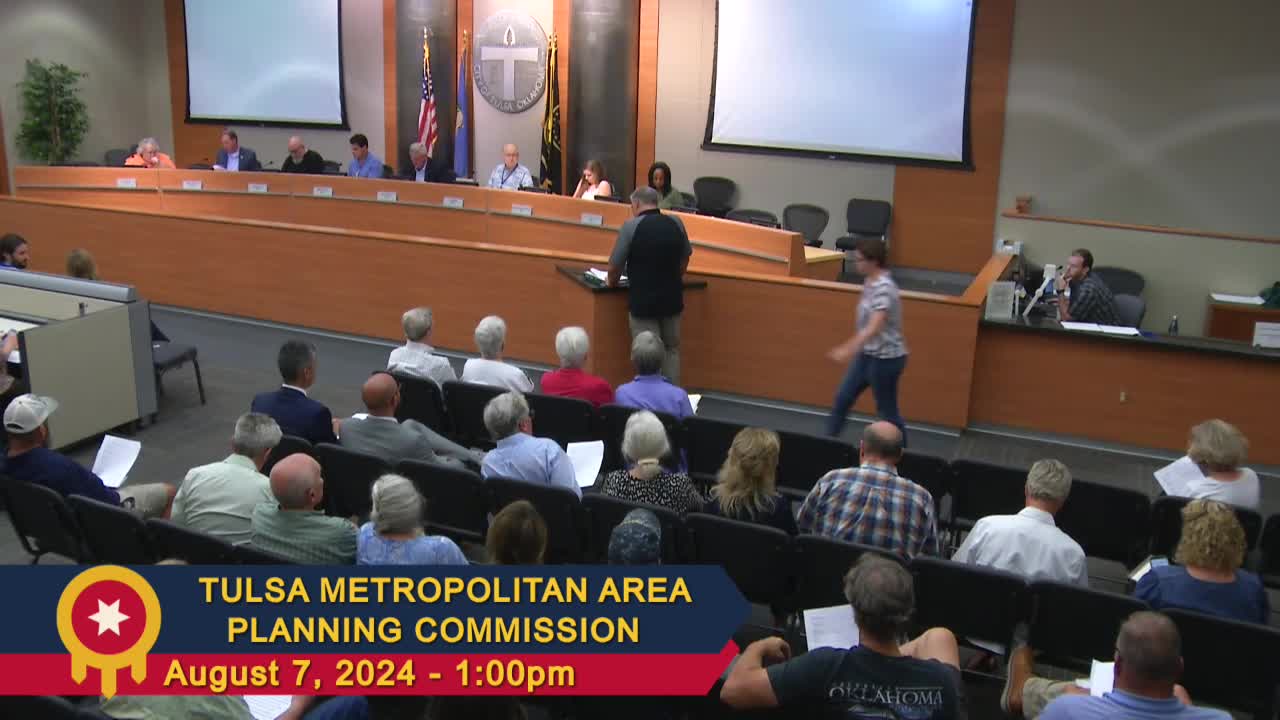Tulsa rezoning plan sparks debate over neighborhood impact
August 07, 2024 | Metropolitan Area Planning Commission Meetings, Tulsa, Tulsa County, Oklahoma
This article was created by AI summarizing key points discussed. AI makes mistakes, so for full details and context, please refer to the video of the full meeting. Please report any errors so we can fix them. Report an error »

A recent government meeting addressed several significant rezoning requests, with a focus on residential and commercial developments in Tulsa County.
One of the primary discussions revolved around a rezoning request for a property located west of the northwest corner of East 100th Street and 51st Street South. The applicant seeks to rezone the area from Agricultural (AG) to Residential Single Family (RS) to facilitate a Planned Unit Development (PUD) aimed at establishing a single-family subdivision. The proposed PUD includes a minimum lot size of 8,400 square feet per dwelling and aligns with the Tulsa County comprehensive plan, which designates the area as Level 1 Rural Residential. City staff recommended approval, asserting that the proposal would not harm surrounding properties and is consistent with future development patterns.
In another case, a rezoning request for a city-owned property near Riverside Drive and Southwest Boulevard was initiated by the Tulsa City Council. The property, currently zoned for mixed uses, is being considered for commercial development along the Arkansas River and Route 66 corridor. The city aims to streamline zoning regulations to facilitate development, with proposals due for review by the end of September.
Additionally, a rezoning and comprehensive plan amendment were proposed for a property on Garnett Road, transitioning from AG to Office Low Intensity (OL) to accommodate a new dental office. The applicant's request aligns with the local center designation in the comprehensive plan, promoting small-scale developments serving surrounding neighborhoods. However, concerns were raised by neighboring residents regarding the potential impact on the area's tree canopy and overall environment.
The meeting also included a discussion on a rezoning application for a site at the northeast corner of East 42nd Street South and South Peoria Avenue. The applicant seeks to rezone the property to Commercial High Intensity (CH) with a development plan that includes a Chick-fil-A restaurant. This proposal aims to enhance the transition between commercial and residential areas, incorporating significant landscaping and screening measures to mitigate impacts on nearby homes.
Overall, the meeting highlighted the ongoing efforts to balance development needs with community concerns, emphasizing the importance of public engagement and environmental considerations in the planning process.
One of the primary discussions revolved around a rezoning request for a property located west of the northwest corner of East 100th Street and 51st Street South. The applicant seeks to rezone the area from Agricultural (AG) to Residential Single Family (RS) to facilitate a Planned Unit Development (PUD) aimed at establishing a single-family subdivision. The proposed PUD includes a minimum lot size of 8,400 square feet per dwelling and aligns with the Tulsa County comprehensive plan, which designates the area as Level 1 Rural Residential. City staff recommended approval, asserting that the proposal would not harm surrounding properties and is consistent with future development patterns.
In another case, a rezoning request for a city-owned property near Riverside Drive and Southwest Boulevard was initiated by the Tulsa City Council. The property, currently zoned for mixed uses, is being considered for commercial development along the Arkansas River and Route 66 corridor. The city aims to streamline zoning regulations to facilitate development, with proposals due for review by the end of September.
Additionally, a rezoning and comprehensive plan amendment were proposed for a property on Garnett Road, transitioning from AG to Office Low Intensity (OL) to accommodate a new dental office. The applicant's request aligns with the local center designation in the comprehensive plan, promoting small-scale developments serving surrounding neighborhoods. However, concerns were raised by neighboring residents regarding the potential impact on the area's tree canopy and overall environment.
The meeting also included a discussion on a rezoning application for a site at the northeast corner of East 42nd Street South and South Peoria Avenue. The applicant seeks to rezone the property to Commercial High Intensity (CH) with a development plan that includes a Chick-fil-A restaurant. This proposal aims to enhance the transition between commercial and residential areas, incorporating significant landscaping and screening measures to mitigate impacts on nearby homes.
Overall, the meeting highlighted the ongoing efforts to balance development needs with community concerns, emphasizing the importance of public engagement and environmental considerations in the planning process.
View full meeting
This article is based on a recent meeting—watch the full video and explore the complete transcript for deeper insights into the discussion.
View full meeting
